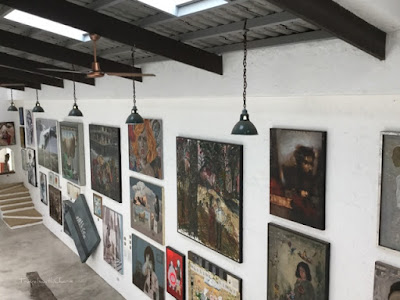 |
| Walang Iwanan, Elmer Borlongan, 1999 |
The Pinto Art Museum has a vast collection of Philippine contemporary art and it requires more than a single visit to appreciate all that it has offer.
I like the playful mood of Walang Iwanan. In Filipino culture, the phrase, "walang iwanan" (no one is left behind) is commonly heard between friends and families. A good friend will always stand by your side.
 |
| Ultimo Cinco, Mark Orozco Justiniani, Oil on canvas, 1993 |
Ultimo Cinco is a parody of Da Vinci's Last Supper. Here the gamblers (which have replaced the 12 apostles) are looking up and anticipating the fall of the die which will decide the fate of their bets.
Justiniani received the 13 Artists Award in 1994 together with his colleague, Elmer Borlongan.
 |
| Karnabal, Salingpusa Collective, Acrylic on canvas, 1992 |
This 12'x40' mural addresses the state of Philippine society after the Marcos era and perhaps thru the present. Notice the central figures - a priest hearing the confession of a clown, a rabid dog, a magician willing the body of a nude woman to levitate, red papier mâché carabaos, a man playing target practice. All these scenes, the heightened excitement stroked in part by the harsh colors and the crowd of characters are indeed reminiscent of a carnival, with the exception of the priest. But that is perhaps the core idea, the relationship between Filipinos and their religion.
Salingpusa is a group of painters founded in the mid 1980s (they celebrated their 30th anniversary in August 2015) by art students from the University of the Philippines. Among its founding members are Elmer Borlongan and Mark Justiniani together with Ferdie Montemayor, John Santos III, Tony Leaño (who designed the museum buildings), Manny Garibay and a host of artists who are now considered the vanguards of Philippine contemporary art. Together they created paintings in which they depicted the Philippine political climate and society of their era.
 |
| Oblivious, Stephanie Lopez, 2010 |
Stephanie Lopez worked with steel wires and found objects to create this delicate composition. Oblivious reminds me of the transparency of emotions and how love can be both gentle and fragile.
Note the portrait in the background. The subject is Dr. Joven Cuanang, the founder of the museum. He is a tireless supporter of Philippine contemporary art and of its artists. It is his vision that brought together these talents and their works into one unique museum. Winner Jumalon is the portraitist.
 |
| Gallery 5 |
In a roomful of art, I'm faced with a question. Where do I begin? It's a daunting task. So I told myself that I will have to return soon to pay more attention to the pieces I glossed over.
 |
| Panalo! by Ferdie Montemayor, Acrylic on canvas, 2012 |
Panalo! is in Gallery 5. It's a triptych composed of swimmers, runners and cyclists. The paintings span an entire wall of the gallery. What an amazing composition of movement with the winner emerging from the pack! Panalo means winner.
 |
| Nona M. Garcia, Hallow, 2010 |
Nona Garcia grew up around the hospital owned by her parents in Marikina. She was fascinated with X-ray charts then and that childhood interest has found its way in some of her works such as the Hallow composition above. Lit shadow boxes frame negatives of religious images of the Santo Niño, the Crucifixion, the Virgin Mary and the saints. Garcia is a recipient of the ASEAN Art Award for 2000 and the Thirteen Artists Award for 2003.
 |
| Gaia, Daniel Delacruz |
Gaia is the Mother Goddess in Greek mythology, the creator of earth and the universe. How apropos that this piece of sculpture is situated among the trees as Gaia is portrayed sprouting from a tree.
 |
| "Papunta ka palang, pabalik na ako", Jaypee Samson, 2009 |
This oil painting had the most impact on me. The title can be loosely translated as "You just began, I'm on my way back". Poignant!
 |
| The Pinto Academy |
"The Foundation built this Academy of Arts and Sciences to promote conversation across disciplines to create, innovate and to pursue activities that celebrate this thought and advance through research its furtherance so that this will be enhanced for the benefit of society." Dr. Joven Cuanang, February 2016"
 |
| Courtyard at the Pinto Academy |
Try to visit the museum on a weekday (except Mondays). I went on a Saturday and it was teeming with visitors and students. There are several restaurants onsite though I could not recommend them except perhaps for ordering beverage. Service is slow and careless. After waiting for more than a half hour, one of the waiters informed me that they no longer had the fish dory I ordered. And he informed me they had no other items on the menu that I could quickly get as most of the dishes required a longer time to prepare. By the way, the fish dory was recommended by our waiter. What a turn off after a morning enjoying the art collection and gardens!
Pinto Art Museum
1 Sierra Madre Heights
Grand Heights Subdivision
Antipolo Hills, Rizal
Open Tuesdays through Sundays from 9 a.m. to 6 p.m.
P200 entrance fee, student and senior citizen discount available
 |
| The Chapel |
If you are staying in Metro Manila, it's best to arrange for an organized tour with your hotel concierge. Antipolo is at least an hour from the Makati business district depending on traffic. Otherwise, ask the hotel to recommend a Grab or Uber driver who can wait for you while you are exploring the museum.
*****
Images by TravelswithCharie